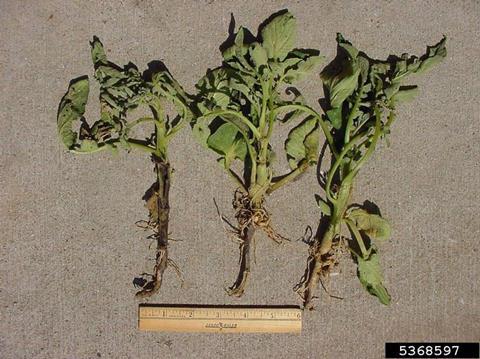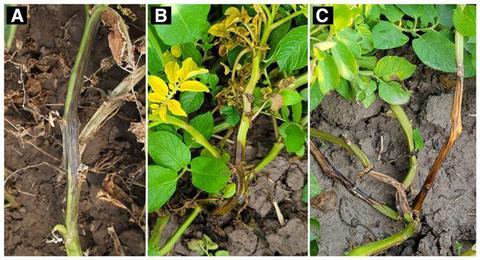Potato growers face a persistent late-season threat: aerial stem rot (ASR), a bacterial disease primarily caused by Pectobacterium carotovorum. Often emerging after thunderstorms and other weather events, ASR has long been a challenge to manage effectively.

While previous research has suggested the potential of copper-based fungicides to control ASR, inconsistent results left many growers uncertain about the products’ reliability. Now, a decade-long study provides conclusive evidence that copper fungicides offer a dependable solution.
READ MORE: New potato-threatening pathogens reported for first time in Pennsylvania, US
READ MORE: Pectin carriers unleash army of predatory bacteria
Published in Plant Health Progress, this comprehensive research effort was led by Phillip S. Wharton of the University of Idaho Department of Entomology, Plant Pathology, and Nematology. The study analyzed 10 years of field trials in which copper-based fungicides were applied weekly, starting at row closure. Researchers assessed disease severity over a 4-week period following symptom onset, using the relative area under the disease progress curve to quantify disease progression. The results confirmed that copper fungicide treatments consistently slowed disease spread and improved yields.
Copper fungicide
“Even though in some years there were no significant differences in disease severity or yield between treated and untreated plots, when viewed over the 10-year period, copper fungicide treatments outperformed the untreated control,” explained Wharton. “Yields were at least 3 tonnes per hectare (27 hundredweight per acre) higher in treated plots, and disease levels were consistently lower.”

This study is the first to thoroughly investigate the efficacy of copper-based fungicides against ASR in potatoes. “Regardless of the formulation, copper fungicides effectively reduced ASR incidence and severity when applied on a 7-day schedule starting at row closure,” noted the research team.
Beyond demonstrating the effectiveness of copper fungicides, the study also underscores the importance of distinguishing ASR from blackleg, another bacterial disease commonly found in potato production. Unlike blackleg, which originates from infected seed pieces and moves upward through the stem, ASR infection begins in the potato canopy and becomes prominent after row closure. This fundamental difference means that while blackleg cannot be controlled through foliar fungicide applications, ASR can be effectively managed with consistent copper fungicide treatments.
Organic production
The findings have significant implications for potato growers and crop consultants. Copper fungicides are not only effective in managing ASR but are also cost-efficient and approved for use in organic potato production. This research reinforces the role of copper-based fungicides as a practical tool for managing late-season bacterial diseases in potatoes.
For additional details, read “Ten-Year Trends in Aerial Stem Rot Management: Evaluating Copper-Based Solutions for Sustainable Potato Cultivation,” published in Plant Health Progress, to learn more.







No comments yet